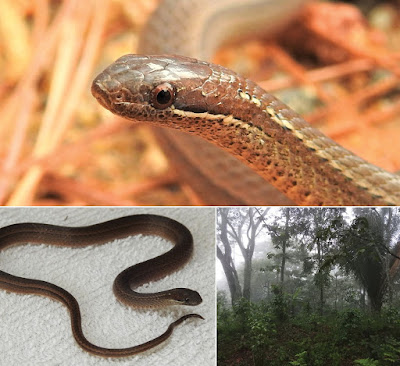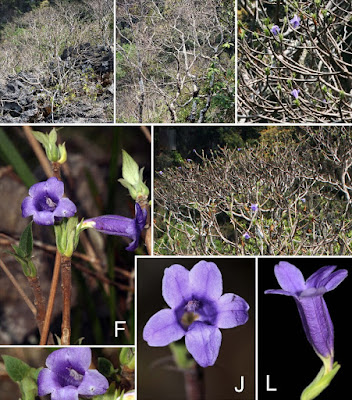[Most Recent Entries] [Calendar View]
Tuesday, January 8th, 2019
| Time | Event | ||||||||
| 2:40a | [Herpetology • 2019] Rhadinaea eduardoi • A New Species of Forest Snake of the Genus Rhadinaea (Squamata, Dipsadidae) from Tropical Montane Rainforest in the Sierra Madre del Sur of Oaxaca, Mexico
Abstract Content of the dipsadid genus Rhadinaea has changed considerably since Myers’ 1974 revision. Three species groups are recognized currently in the genus. Our fieldwork in Oaxaca in June 2018 produced a single specimen of Rhadinaea considered to represent a new taxon. This new species is described from converted Premontane Wet Forest in the municipality of Santa Catarina Juquila in the Sierra Madre del Sur of southern Oaxaca, Mexico. It is most closely related to Rhadinaea laureata, from which it can be distinguished easily by color pattern and scutellation, and represents a species group distinct from the other three occupying the genus. Keywords: Morphology, new serpent species, Santa Catarina Juquila municipality, Southern Mexico, taxonomy
Rhadinaea eduardoi sp. n. Common name: English: Eduardo’s forest snake. Spanish: Hojarasquera de Eduardo Diagnosis: A snake of the genus Rhadinaea that can be distinguished from all congeners by the following combination of morphological features: supralabials 7, with 3rd and 4th entering orbit; 120 ventrals; 71 subcaudals; one subpreocular (lower preocular); 17 dorsal scales throughout body; a head pattern lacking postorbital pale markings but having a pale line extending from the lower rear quadrant of the eye to the ultimate supralabial and slightly beyond, and a midbody dorsal color pattern of a lateral series of black dots in the lower apex of the scales of row V and a middorsal line confined to the middorsal scale row consisting of a series of disjunct spots on the posterior apex of otherwise dark brown scales. Etymology: This species is named in honor of Eduardo Mata-Silva, collector of the holotype. Eduardo is the younger brother of the senior author of this paper, is a resident of Río Grande, Oaxaca, and is a highly valued member of our field crew working in Oaxaca. He also outshines the rest of the crew when it comes to finding snakes, as evidenced by his discovery of the holotype of the snake described herein. Habitat and natural history observations: Rhadinaea eduardoi is resident in an area of converted Premontane Wet Forest, which presently supports a plantation of shade-grown coffee (Fig. 5). The holotype was found active at 1800 hrs on leaf litter approximately 10 m from a stream after a very light rain. Other herpetofaunal species encountered at this site were the anurans Craugastor pygmaeus, Ptychohyla leonhardschultzei, and Exerodonta sumichrasti, and the lizards Norops sp. and Holcosus undulatus.
Vicente Mata-Silva, Arturo Rocha, Aurelio Ramírez-Bautista, Christian Berriozabal-Islas and Larry David Wilson. 2019. A New Species of Forest Snake of the Genus Rhadinaea from Tropical Montane Rainforest in the Sierra Madre del Sur of Oaxaca, Mexico (Squamata, Dipsadidae). ZooKeys. 813: 55-65. DOI: 10.3897/zookeys.813.29617 Resúmen: La conformación del género Rhadinaea ha cambiado considerablemente desde la revisión de Myers en 1974. Tres grupos de especies son reconocidos actualmente en el género. Nuestro trabajo de campo en Oaxaca en junio de 2018 produjo un espécimen de Rhadinaea que consideramos que representa un nuevo taxón. Describimos esta nueva especie de bosque húmedo premontano en el Municipio de Santa Catarina Juquila en la Sierra Madre del Sur en el sur de Oaxaca, México. Esta especie está más estrechamente relacionada con Rhadinaea laureata, de la cual se puede distinguir fácilmente por medio del patrón de color y escutelación, y representa un grupo distinto a los tres que forman parte del género. Palabras claves: Morfología, nueva especie de serpiente, municipalidad de Santa Catarina Juquila, el sur de México, taxonomía | ||||||||
| 5:33p | [Botany • 2018] Xylacanthus laotica (Acanthaceae, Acanthoideae) • A New Genus and Species from Laos
Summary: A new monotype genus Xylacanthus Aver. et K. S. Nguyen with one species, X. laotica Aver. et K. S. Nguyen (Acanthaceae, Acanthoideae, Ruellieae), is described and illustrated. Described genus has arborous living form rather unusual among in Acanthaceae. This small deciduous tree was observed as a main co-dominant of primary deciduous xerophytic karst scrub on extra dry tops of remnant limestone mountains in Pon Xay district of Luang Prabang province in central part of northern Laos. New genus has rather isolated taxonomic position for its floral morphology, xerophytic living form and obligatory deciduous xerophytic character. The distribution of this plant is limited by limestone karstic areas of central part of northern Laos in the limits of Luang Prabang province. Keywords: Acanthaceae, karstic flora, Laos, new genus, plant endemism, plant taxonomy, Xylacanthus. Xylacanthus Aver. et K. S. Nguyen, gen. nov. Type: X. laotica Aver. et K. S. Nguyen Monotype genus. Description: Deciduous monoecious tree to 5 m tall flowering and fruiting before leaf formation; shoots isophyllous; leaves in terminal rosette, opposite, decussate, pilose; flowers solitary, axillary, sessile; floral bracts 0–2, lanceolate, villose, persistent; calyx 5-lobed, villose, with many cystoliths; corolla dark blue, cylindric, hairy, 5-lobed, lobes rounded, recurved, forming almost actinomorphic limb; stamens 4, didynamous, monadelphous, all fertile, pairwise distally connivent, filaments glandular hairy, at base with many long hairs; anthers basifixed, 2-thecous, thecae with prominent recurved, sterile, acuminate base; connective with many long hairs; ovary erect, narrowly ovoid, setose, 2-locular; style filiform, comose; stigma 2-cleft; capsule ellipsoid, shortly hairy, 6–8-seeded; seeds lenticular, pilose with appressed mucilaginous hairs. Etymology: Generic name refers to an arboreous plant habit. Note: The discovered plant superficially somewhat resembles species of Strobilanthes Blume, large widespread genus well presented in tropical southeast Asia and in countries of Indochinese Peninsular as well (Benoist, 1935; Pham Hoang Ho, 2000; Deng et al., 2006, 2011; Newman et al., 2007). However, it strikingly differs from all known Strobilanthes species in its unusual arborous plant habit, spurred anthers, filaments and anther connective densely hairy with long white hairs, as well as in many (more than 4)-seeded capsule. Some of these characters, as well as similar pollen grain structure, remind representative of the genus Echinacanthus Nees. However, the only true Echinacanthus species (E. attenuatus Nees) is a lowland slender herb of the Nepal-Darjeeling area, which is totally different in habit from our plant being also geographically separated. It is highly probable that discovered plant represents new undescribed genus endemic for limestone areas of central Laos. Like its expected relatives, it may be placed into subtribe Strobilanthinae (Acanthaceae, subfam. Acanthoideae, tribe Ruellieae) in the family classification proposed by A. Takhtajan (2009). Newly described genus includes one species described below. Xylacanthus laotica Aver. et K. S. Nguyen, sp. nov. Etymology The species epithet refers to the country of its origin. Distribution Northern Laos, Luang Prabang province, Pon Xay district (Houay Man, Nam Bo and Bane Phou Souong villages). Endemic. Note: This remarkable plant strikingly differs from almost all known representatives of Acanthaceae family in its arborous living form, xerophytic deciduous character, as well as flowering and fruiting before leaves formation. Oldest observed trees have age at least 2–3 decades and stands in obvious contrast with herbaceous and semi-woody commonly pliestesial Acanthaceae species commonly adopted to humid conditions of shady wet evergreen forests. Like many deciduous xerophytes of extra dry exposed karstic fields, described species has fairly short period of vegetation forming leaves only during rainy season from middle April till September. Tree remains completely leafless during dry rainless winter. Described monotype genus represents typical element of ancient strictly endemic xerophytic limestone flora historically adapted to extra dry summits of karstic limestone formations of northern Laos. This curious, highly specialized flora includes many convergent xerophytic derivates from different families. Unfortunately, it remains still weakly studied. Some other remarkable plants described recently from extra dry karstic limestone fields of northern Laos (Averyanov, Nguyen, 2012; Pimenov et al., 2016) are also similarly woody deciduous xerophytes, e. g. Begonia viscosa (Begoniaceae) and Xyloselinum laoticum (Apiaceae). Like X. laotica, these species also strikingly differ from its herbaceous mesophytic congeners. L. V. Averyanov, K. S. Nguyen and T. V. Maisak. 2018. Xylacanthus laotica (Acanthaceae, Acanthoideae), A New Genus and Species from Laos. Turczaninowia. 21(2); 101–110 DOI: 10.14258/turczaninowia.21.2.11 Аннотация. Новый монотипный род Xylacanthus Aver. et K. S. Nguyen с единственным видом, X. laotica Aver. et K. S. Nguyen (Acanthaceae, Acanthoideae, Ruellieae), описан в качестве нового для науки. Описание сопровождается цветными фотографиями и черно-белыми рисунками. Описываемое растение имеет древесную жизненную форму, что крайне редко встречается в семействе Acanthaceae. Открытый вид представляет из себя маленькое листопадное деревцо, являющееся главным доминантом первичной ксерофильной листопадной кустарниковой растительности, покрывающей исключительно сухие карстовые обитания на вершинах известняковых столовых останцев района Пхонсай провинции Луангпхабанг в центральной части северного Лаоса. Новый род занимает изолированное таксономическое положение по морфологии цветка, ксерофитному древесному характеру жизненной формы и облигатной листопадности. Распространение этого растения ограничено карстовыми реликтовыми скальными известняками центральной части северного Лаоса в пределах провинции Луангпхабанг. Ключевые слова: карстовые флоры, Лаос, новый род, таксономия растений, эндемизм растений, Acanthaceae, Xylacanthus. Л. В. Аверьянов, К. С. Нгуен, Т. В. Майсак. 2018. Xylacanthus laotica (Acanthaceae, Acanthoideae) – новый род и вид из Лаоса. Turczaninowia. 21(2); 101–110 DOI: 10.14258/turczaninowia.21.2.11 |
| << Previous Day |
2019/01/08 [Calendar] |
Next Day >> |







